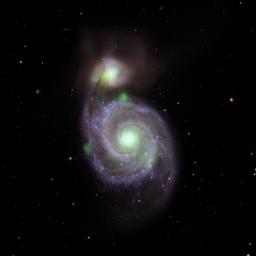 HEAPOW: Falling into the Whirlpool (2019 May 13)
HEAPOW: Falling into the Whirlpool (2019 May 13)
Despite the emptiness of outer space, cosmic collisions between galaxies are fairly common. One of the best examples is Messier 51, which consists of a large spiral galaxy, M51a, known more commonly as the Whirlpool, and a smaller companion galaxy, M51b, with a bridge of stars connecting them. The two galaxies collided in the dim, distant past, and M51b is inexorably spiralling into the Whirlpool. Both the Whirlpool and M51b have central supermassive black holes and, since each is viewed face on from earth, the system provides an outstanding opportunity to study how galaxy collisions help feed supermassive black holes. Scientists think that such titanic collisions should drive material into the maws of the central supermassive black holes, increasing their size and making them shine brightly in X-rays. Oddly enough, observations with the Chandra X-ray Observatory and other X-ray observatories have shown that the supermassive black holes in the M51 galaxies are unexpectedly faint. However, material near the black holes might block some of the X-ray emission, so that the observed emission might severely underestimate the true activity. The NuSTAR X-ray observatory provides the unique capability to make images at very high X-ray energies, and these high energy ("hard") X-rays can penetrate through huge amounts of absorbing material and give us an unobscured view of the supermassive black holes in M51. The image above shows the NuSTAR image of M51 in green, superimposed on an optical image. The NuSTAR observations show that both central black holes are hard X-ray sources, but confirm that the supermassive black holes in M51 are actually intrinsically faint, and apparently dainty eaters. This is a puzzle to astronomers, and perhaps suggests that supermassive black holes in interacting galaxies only feed sporadically, with X-ray active periods interspersed with long periods of inactivity. Interestingly, NuSTAR also shows that one of the brightest X-ray sources in the Whirlpool, the green dot near the outer spiral arm of the galaxy on the left of the image, is a neutron star. This X-ray source is so bright that it is classified as a rare ultra-luminous X-ray source, or ULX. Its not clear why this neutron star, about a million times less massive than the supermassive black holes, is such a bright hard X-ray source. Astronomers think that perhaps the X-ray emission is produced somehow by the neutron star's superstrong magnetic field, though the details are not yet fully understood.
NuSTAR: In Colliding Galaxies, a Pipsqueak Shines Bright
viewtopic.php?t=39191
| << Previous HEAPOW | High Energy Astrophysics Picture of the Week | Next HEAPOW >> |
